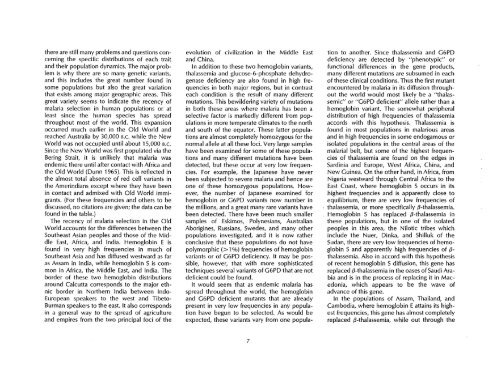SCOOTER82a_Livingstone_Frequencies of Hemoglobin Variants ...
SCOOTER82a_Livingstone_Frequencies of Hemoglobin Variants ...
SCOOTER82a_Livingstone_Frequencies of Hemoglobin Variants ...
You also want an ePaper? Increase the reach of your titles
YUMPU automatically turns print PDFs into web optimized ePapers that Google loves.
there are still many problems and questions concerning<br />
the specific distributions <strong>of</strong> each trait<br />
and their population dynamics. The major problem<br />
is why there are so many genetic variants,<br />
and this includes the great number found in<br />
some populations but also the great variation<br />
that exists among major geographic areas. This<br />
great variety seems to indicate the recency <strong>of</strong><br />
malaria selection in human populations or: at<br />
least since the human species has spread<br />
throughout most <strong>of</strong> the world. This expansion<br />
occurred much earlier in the Old World and<br />
reached Australia by 30,000 B.C. while the New<br />
World was not occupied until about 15,000 B.C.<br />
Since the New World was first populated via the<br />
Bering Strait, it is unlikely that malaria was<br />
endemic there until after contact with Africa and<br />
the Old World (Dunn 1965). This is reflected in<br />
the almost total absence <strong>of</strong> red cell variants in<br />
the Amerindians except where they have been<br />
in contact and admixed with Old World immigrants.<br />
(For these frequencies and others to be<br />
discussed, no citations are given; the data can be<br />
found in the table.)<br />
The recency <strong>of</strong> malaria selection in the Old<br />
World accounts for the differences between the<br />
Southeast Asian peoples and those <strong>of</strong> the Middle<br />
East, Africa, and India. <strong>Hemoglobin</strong> E is<br />
found in very high frequencies in much <strong>of</strong><br />
Southeast Asia and has diffused westward as far<br />
as Assam in India, while hemoglobin S is common<br />
in Africa, the Middle East, and India. The<br />
border <strong>of</strong> these two hemoglobin distributions<br />
around Calcutta corresponds to the major ethnic<br />
border in Northern India between Indo<br />
European speakers to the west and Tibeto<br />
Burman speakers to the east. It also corresponds<br />
in a general way to the spread <strong>of</strong> agriculture<br />
and empires from the two principal foci <strong>of</strong> the<br />
evolution <strong>of</strong> civilization in the Middle East<br />
and China.<br />
In addition to these two hemoglobin variants,<br />
thalassemia and glucose-6-phosphate dehydrogenase<br />
deficiency are also found in high frequencies<br />
in both major regions, but in contrast<br />
each condition is the result <strong>of</strong> many different<br />
mutations. This bewildering variety <strong>of</strong> mutations<br />
in both these areas where malaria has been a<br />
selective factor is markedly different from populations<br />
in more temperate climates to the north<br />
and south <strong>of</strong> the equator. These latter populations<br />
are almost completely homozygous for the<br />
normal allele at all these loci. Very large samples<br />
have been examined for some <strong>of</strong> these populations<br />
and many different mutations have been<br />
detected, but these occur at very low frequencies.<br />
For example, the Japanese have never<br />
been subjected to severe malaria and hence are<br />
one <strong>of</strong> these homozygous populations. However,<br />
the number <strong>of</strong> Japanese examined for<br />
hemoglobin or G6PD variants now number in<br />
the millions, and a great many rare variants have<br />
been detected. There have been much smaller<br />
samples <strong>of</strong> Eskimos, Polynesians, Australian<br />
Aborigines, Russians, Swedes, and many other<br />
populations investigated, and it is now rather<br />
conclusive that these populations do not have<br />
polymorphic (>1%) frequencies <strong>of</strong> hemoglobin<br />
variants or <strong>of</strong> G6PD deficiency. It may be possible,<br />
however, that with more sophisticated<br />
techniques several variants <strong>of</strong> G6PD that are not<br />
deficient could be found.<br />
It would seem that as endemic malaria has<br />
spread throughout the world, the hemoglobin<br />
and G6PD deficient mutants that are already<br />
present in very low frequencies in any population<br />
have begun to be selected. As would be<br />
expected, these variants vary from one popula-<br />
7<br />
tion to another. Since thalassemia and G6PD<br />
deficiency are detected by "phenotypic" or<br />
functional differences in the gene products,<br />
many different mutations are subsumed in each<br />
<strong>of</strong> these clinical conditions. Thus the first mutant<br />
encountered by malaria in its diffusion throughout<br />
the world would most likely be a "thalassemic"<br />
or "G6PD deficient" allele rather than a<br />
hemoglobin variant. The somewhat peripheral<br />
distribution <strong>of</strong> high frequencies <strong>of</strong> thalassemia<br />
accords with this hypothesis. Thalassemia is<br />
found in most populations in malarious areas<br />
and in high frequencies in some endogamous or<br />
isolated populations in the central areas <strong>of</strong> the<br />
malarial belt, but some <strong>of</strong> the highest frequencies<br />
<strong>of</strong> thalassemia are found on the edges in<br />
Sardinia and Europe, West Africa, China, and<br />
New Guinea. On the other hand, in Africa, from<br />
Nigeria westward through Central Africa to the<br />
East Coast, where hemoglobin S occurs in its<br />
highest frequencies and is apparently close to<br />
equilibrium, there are very low frequencies <strong>of</strong><br />
thalassemia, or more specifically ,8-thalassemia.<br />
<strong>Hemoglobin</strong> S has replaced ,8-thalassemia in<br />
these populations, but in one <strong>of</strong> the isolated<br />
peoples in this area, the Nilotic tribes which<br />
include the Nuer, Dinka, and Shilluk <strong>of</strong> the<br />
Sudan, there are very low frequencies <strong>of</strong> hemoglobin<br />
S and apparently high frequencies <strong>of</strong> ,8thalassemia.<br />
Also in accord with this hypothesis<br />
<strong>of</strong> recent hemoglobin S diffusion, this gene has<br />
replaced ,8-thalassemia in the oases<strong>of</strong> Saudi Arabia<br />
and is in the process <strong>of</strong> replacing it in Macedonia,<br />
which appears to be the wave <strong>of</strong><br />
advance <strong>of</strong> this gene.<br />
In the populations <strong>of</strong> Assam, Thailand, and<br />
Cambodia, where hemoglobin E attains its highest<br />
frequencies, this gene has almost completely<br />
replaced ,8-thalassemia, while out through the


